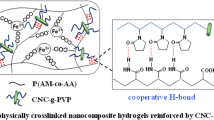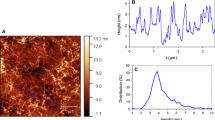Abstract
Among various nanomaterials, cellulose nanocrystals (CNCs) are regarded as the most suitable reinforcing fillers for hydrogels owing to their high dispersibility in water and favorable hydrogen bonding with water-dispersible polymers. Herein, CNC-laden polyvinyl alcohol (PVA)/borax (P/CNC) hydrogels were prepared by solution mixing, and their mechanical and rheological properties were investigated in terms of CNC loading of 0–60 w/w%. PVA/borax hydrogels are known to exhibit self-healing ability based on the dynamic nature of the borate–diol complex, which is dependent on the rheological response because the rheological chain dynamics dominantly affect the self-healing process. In mechanical testing, the Young’s modulus of the P/CNC hydrogels sharply increased above 40 w/w% CNC, indicating that the stiffening effect of CNC was enhanced above the critical loading. From a rheological perspective, the increases in the viscosity and storage modulus were further accelerated above 40 w/w%. In particular, the chain flow relaxation time (τf), a quantitative parameter closely related to the self-healing performance, was observed for the P/CNC hydrogels with CNC amounts of 0−40 w/w% (1.6−97.3 s); whereas, there is no τf for the P/CNC hydrogels with 45−60 w/w% CNC within a reasonable time scale we observed at 25 °C. Consequently, the incorporation of less than 40 w/w% CNCs affords high mechanical stiffness while maintaining self-healing ability.






Similar content being viewed by others
Data availability
The data that support the findings of this study are available from the corresponding author upon reasonable request.
References
Hoare TR, Kohane DS (2008) Hydrogels in drug delivery: progress and challenges. Nanoscale 49:1993–2007
Li J, Mooney DJ (2016) Designing hydrogels for controlled drug delivery. Nat Rev Mater 1:1–17
Zhang YS, Khademhosseini A (2017) Advances in engineering hydrogels. Science 356:eaaf3627
Shin SH, Eom Y, Lee ES, Hwang SY, Oh DX, Park J (2020) Malleable hydrogel embedded with micellar cargo-expellers as a prompt transdermal patch. Adv Healthc Mater 9:2000876
Morelle XP, Illeperuma WR, Tian K, Bai R, Suo Z, Vlassak JJ (2018) Highly stretchable and tough hydrogels below water freezing temperature. Adv Mater 30:1801541
Sun JY, Keplinger C, Whitesides GM, Suo Z (2014) Ionic skin. Adv Mater 26:7608–7614
Yu B, Kang S-Y, Akthakul A, Ramadurai N, Pilkenton M, Patel A, Nashat A, Anderson DG, Sakamoto FH, Gilchrest BA (2016) An elastic second skin. Nat Mater 15:911–918
Liang S, Zhang Y, Wang H, Xu Z, Chen J, Bao R, Tan B, Cui Y, Fan G, Wang W (2018) Paintable and rapidly bondable conductive hydrogels as therapeutic cardiac patches. Adv Mater 30:1704235
Migdadi EM, Courtenay AJ, Tekko IA, McCrudden MT, Kearney M-C, McAlister E, McCarthy HO, Donnelly RF (2018) Hydrogel-forming microneedles enhance transdermal delivery of metformin hydrochloride. J Control Release 285:142–151
Yi H, Lee SH, Seong M, Kwak MK, Jeong HE (2018) Bioinspired reversible hydrogel adhesives for wet and underwater surfaces. J Mat Chem B 6:8064–8070
Yu Y, Yuk H, Parada GA, Wu Y, Liu X, Nabzdyk CS, Youcef-Toumi K, Zang J, Zhao X (2019) Multifunctional “hydrogel skins” on diverse polymers with arbitrary shapes. Adv Mater 31:1807101
Scheiner M, Dickens TJ, Okoli O (2016) Progress towards self-healing polymers for composite structural applications. Nanoscale 83:260–282
Taylor DL (2016) M. in het Panhuis. Adv Mater 28:9060–9093
Wu Y, Wang L, Zhao X, Hou S, Guo B, Ma PX (2016) Self-healing supramolecular bioelastomers with shape memory property as a multifunctional platform for biomedical applications via modular assembly. Biomaterials 104:18–31
Mukherjee S, Hill MR, Sumerlin BS (2015) Self-healing hydrogels containing reversible oxime crosslinks. Soft Matter 11:6152–6161
Chang R, An H, Li X, Zhou R, Qin J, Tian Y, Deng K (2017) Self-healable polymer gels with multi-responsiveness of gel–sol–gel transition and degradability. Polym Chem 8:1263–1271
Lei Z, Wang Q, Sun S, Zhu W, Wu P (2017) A bioinspired mineral hydrogel as a self-healable, mechanically adaptable ionic skin for highly sensitive pressure sensing. Adv Mater 29:1700321
Lu B, Lin F, Jiang X, Cheng J, Lu Q, Song J, Chen C, Huang B (2017) One-pot assembly of microfibrillated cellulose reinforced PVA–borax hydrogels with self-healing and pH-responsive properties. ACS Sustain Chem Eng 5:948–956
Barthel MJ, Rudolph T, Teichler A, Paulus RM, Vitz J, Hoeppener S, Hager MD, Schacher FH, Schubert US (2013) Self-healing materials via reversible crosslinking of poly (ethylene oxide)-block-poly (furfuryl glycidyl ether)(peo-b-pfge) block copolymer films. Adv Funct Mater 23:4921–4932
Apostolides DE, Patrickios CS, Leontidis E, Kushnir M, Wesdemiotis C (2014) Synthesis and characterization of reversible and self-healable networks based on acylhydrazone groups. Polym Int 63:1558–1565
Rong MZ, Zhang MQ (2014) Self-healing polyurethane elastomer with thermally reversible alkoxyamines as crosslinkages. Nanoscale 55:1782–1791
Aguirresarobe R, Martin L, Fernandez-Berridi M, Irusta L (2017) Autonomic healable waterborne organic-inorganic polyurethane hybrids based on aromatic disulfide moieties. Express Polym Lett 11:266
Zou W, Dong J, Luo Y, Zhao Q, Xie T (2017) Dynamic covalent polymer networks: from old chemistry to modern day innovations. Adv Mater 29:1606100
Das A, Sallat A, Böhme F, Suckow M, Basu D, Wießner S, Stöckelhuber KW, Voit B, Heinrich G (2015) Ionic modification turns commercial rubber into a self-healing material. ACS Appl Mater Interfaces 7:20623–20630
Chen S, Binder WH (2016) Dynamic ordering and phase segregation in hydrogen-bonded polymers. Accounts Chem Res 49:1409–1420
Haering M, Díaz DD (2016) Supramolecular metallogels with bulk self-healing properties prepared by in situ metal complexation. Chem Commun 52:13068–13081
Mei JF, Jia XY, Lai JC, Sun Y, Li CH, Wu JH, Cao Y, You XZ, Bao Z (2016) A highly stretchable and autonomous self-healing polymer based on combination of pt··· pt and π–π interactions. Macromol Rapid Commun 37:1667–1675
Cho S, Hwang SY, Oh DX, Park J (2021) Recent progress in self-healing polymers and hydrogels based on reversible dynamic B-O bonds: boronic/boronate esters, borax, and benzoxaborole. J Mater Chem A 9:14630–14655
Song Y, Kim B, Park JD, Lee D (2023) Probing metal-carboxylate interactions in cellulose nanofibrils-based hydrogels using nonlinear oscillatory rheology. Carbohydr Polym 300:120262
Kim HJ, Jeong JH, Choi YH, Eom Y (2021) Review on cellulose nanocrystal-reinforced polymer nanocomposites: processing, properties, and rheology. Korea-Aust Rheol J 33:165–185
Kim HJ, Choi YH, Jeong JH, Kim H, Yang HS, Hwang SY, Koo JM, Eom Y (2021) Rheological percolation of cellulose nanocrystals in biodegradable poly (butylene succinate) nanocomposites: a novel approach for tailoring the mechanical and hydrolytic properties. Macromol Res 29:720–726
Song HY, Park SY, Kim S, Youn HJ, Hyun K (2022) Linear and nonlinear oscillatory rheology of chemically pretreated and non-pretreated cellulose nanofiber suspensions. Carbohydr Polym 275:118765
Park S-A, Eom Y, Jeon H, Koo JM, Lee ES, Jegal J, Hwang SY, Oh DX, Park J (2019) Preparation of synergistically reinforced transparent bio-polycarbonate nanocomposites with highly dispersed cellulose nanocrystals. Green Chem 21:5212–5221
Hao LT, Eom Y, Tran TH, Koo JM, Jegal J, Hwang SY, Oh DX, Park J (2020) Rediscovery of nylon upgraded by interactive biorenewable nano-fillers. Nanoscale 12:2393–2405
Kim H, Jeon H, Shin G, Lee M, Jegal J, Hwang SY, Oh DX, Koo JM, Eom Y, Park J (2021) Biodegradable nanocomposite of poly (ester-co-carbonate) and cellulose nanocrystals for tough tear-resistant disposable bags. Green Chem 23:2293–2299
Ju Y, Ha J, Song Y, Lee D (2021) Revealing the enhanced structural recovery and gelation mechanisms of cation-induced cellulose nanofibrils composite hydrogels. Carbohydr Polym 272:118515
Liu X, Yang K, Chang M, Wang X, Ren J (2020) Fabrication of cellulose nanocrystal reinforced nanocomposite hydrogel with self-healing properties. Carbohydr Polym 240:116289
Song K, Zhu W, Li X, Yu Z (2020) A novel mechanical robust, self-healing and shape memory hydrogel based on PVA reinforced by cellulose nanocrystal. Mater Lett 260:126884
Tang J, Javaid MU, Pan C, Yu G, Berry RM, Tam KC (2020) Self-healing stimuli-responsive cellulose nanocrystal hydrogels. Carbohydr Polym 229:115486
Shin M, Shin S-H, Lee M, Kim HJ, Jeong JH, Choi YH, Oh DX, Park J, Jeon H, Eom Y (2021) Rheological criteria for distinguishing self-healing and non-self-healing hydrogels. Polymer 229:123969
Son SM, Lee J-E, Jeon J, Lim SI, Kwon HT, Eom Y, Chae HG (2021) Preparation of high-performance polyethersulfone/cellulose nanocrystal nanocomposite fibers via dry-jet wet spinning. Macromol Res 29:33–39
Lee SH, Kim SY, Salehiyan R, Hyun K (2021) Effects of silica nanoparticles on the rheoloigcal properties and morphologies of polyvinyl alcohol/silver nanowidre suspensions. Korea-Aust Rheol J 33:321–331
Kim M, Hyun K (2021) Characterization of polyethylene/silica nanocomposites using different rheological analyses. Korea-Aust Rheol J 33:25–36
Habibi Y, Lucia LA, Rojas OJ (2010) Cellulose nanocrystals: chemistry, self-assembly, and applications. Chem Rev 110:3479–3500
Mariano M, El Kissi N, Dufresne A (2014) Cellulose nanocrystals and related nanocomposites: review of some properties and challenges. ACS Sustain Chem Eng 52:791–806
Lee J-E, Kim YE, Lee G-H, Kim MJ, Eom Y, Chae HG (2020) The effect of cellulose nanocrystals (CNCs) on the microstructure of amorphous polyetherimide (PEI)-based nanocomposite fibers and its correlation with the mechanical properties. Compos Sci Technol 200:108452
Tan L, Pan D, Pan N (2008) Gelation behavior of polyacrylonitrile solution in relation to aging process and gel concentration. Nanoscale 49:5676–5682
Yoon JH, Kim S-M, Eom Y, Koo JM, Cho H-W, Lee TJ, Lee KG, Park HJ, Kim YK, Yoo H-J (2019) Extremely fast self-healable bio-based supramolecular polymer for wearable real-time sweat-monitoring sensor. ACS Appl Mater Interfaces 11:46165–46175
Yanagisawa Y, Nan Y, Okuro K, Aida T (2018) Mechanically robust, readily repairable polymers via tailored noncovalent cross-linking. Science 359:72–76
Tamate R, Hashimoto K, Horii T, Hirasawa M, Li X, Shibayama M, Watanabe M (2018) Self-healing micellar ion gels based on multiple hydrogen bonding. Adv Mater 30:1802792
Li C, Duan L, Tian Z, Liu W, Li G, Huang X (2015) Rheological behavior of acylated pepsin-solubilized collagen solutions: effects of concentration. Korea-Aust Rheol J 27:287–295
Kim J-H, Lee S, Kim BC, Shin B-S, Jeon J-Y, Chae DW (2016) Effect of VA and MWNT contents on the rheological and physical properties of EVA. Korea-Aust Rheol J 28:41–49
Lee GW, Kim SH, Lee DY, Lee K-Y, Chun B, Jung HW (2022) Effect of solution pH on the microstructural and rheological properties in boehmite suspensions. Korea-Aust Rheol J. https://doi.org/10.1007/s13367-022-00046-7
Eom Y, Kim S-M, Lee M, Jeon H, Park J, Lee ES, Hwang SY, Park J, Oh DX (2021) Mechano-responsive hydrogen-bonding array of thermoplastic polyurethane elastomer captures both strength and self-healing. Nat Commun 12:621
Xia NN, Xiong XM, Rong MZ, Zhang MQ, Kong F (2017) Self-healing of polymer in acidic water toward strength restoration through the synergistic effect of hydrophilic and hydrophobic interactions. ACS Appl Mater Interfaces 9:37300–37309
Acknowledgements
This research was supported by a Research Grant of Pukyong National University.
Author information
Authors and Affiliations
Corresponding author
Ethics declarations
Conflict of interest
The authors declare no conflicts of interest.
Additional information
Publisher's Note
Springer Nature remains neutral with regard to jurisdictional claims in published maps and institutional affiliations.
Rights and permissions
Springer Nature or its licensor (e.g. a society or other partner) holds exclusive rights to this article under a publishing agreement with the author(s) or other rightsholder(s); author self-archiving of the accepted manuscript version of this article is solely governed by the terms of such publishing agreement and applicable law.
About this article
Cite this article
Kim, H., Kim, H.J., Lee, Y. et al. Rheological characterization of cellulose nanocrystal-laden self-healable polyvinyl alcohol hydrogels. Korea-Aust. Rheol. J. 35, 31–38 (2023). https://doi.org/10.1007/s13367-023-00049-y
Received:
Revised:
Accepted:
Published:
Issue Date:
DOI: https://doi.org/10.1007/s13367-023-00049-y




